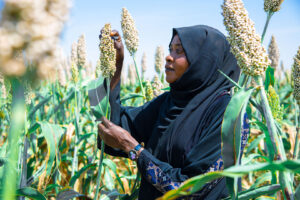
By Shawn McGuire, Seed Security Officer at FAO
When communities are affected by crises – whether caused by natural disasters, conflict, or chronic stresses – ensuring access to seeds for food production is vital for community recovery and resilience. Seed Security Assessments (SSAs) are pivotal in shaping effective seed-related interventions.
Seed aid, long viewed as a cost-effective way to help farmers recover after disasters, has been a mainstay of humanitarian response for decades. Large-scale seed distributions are common – for instance, FAO recently targeted 1.2 million households in Sudan, with 520,000 households currently reached. However, many seed aid activities mainly use food insecurity data for their design. A global FAO study revealed that 90% of seed aid interventions between 2005 and 2015 were not informed by seed-specific, tailored assessments.
The dominant mode of seed aid is in-kind seed distribution. However, relying on a one-size-fits-all approach overlooks the complexities of local seed systems and the diverse needs of farmers. Seed security is distinct from food security: it requires understanding the specific dynamics of seed availability, access, and quality that farmers and communities experience. SSAs offer a nuanced, evidence-based approach that examine the unique dynamics of seed systems in specific regions.[1] For example, seeds may still be available after a crisis, with farmers’ main constraint being a lack of financial or other means to access these seeds. In such situations, in-kind seed distributions do not tackle the main constraint, which is better addressed through cash or voucher approaches. Worse, in-kind distribution may cause indirect harm to local seed markets, causing longer-term impacts.
Since 2010, SSAs have been conducted in over 25 countries by different agencies, using a framework that considers the needs of vulnerable groups, such as internally displaced persons and women-headed households. These assessments provide a comprehensive analysis of different seed systems – both formal and informal – that farmers rely on. They examine the specific constraints farmers face in accessing seeds and evaluate how acute and chronic stresses, such as droughts or market disruptions, impact seed security. With these data, short-term responses and longer-term strategies can be developed and tailored to build resilience among farming communities.
Tools, such as FAO’s Practitioners Guide and the Seed System Security Assessments (SSSAs),[2] provide structured approaches for conducting SSAs. SEADS Standards also emphasize SSAs as a critical prior step to guide how aid is provided, and there is growing recognition of the importance of data-driven decisions in humanitarian efforts. Despite this, SSAs occur too infrequently.
Challenges in building capacity for SSAs
Leading an SSA is complex, requiring not only technical knowledge of formal and informal seed systems, but also facilitation skills, data analysis expertise, and the ability to translate findings into actionable recommendations. A key obstacle to the widespread use of SSAs is the shortage of experts with the necessary skill set and practical experience, and there is an urgent need to build capacity through targeted training efforts. This is particularly critical in areas such as Yemen and Afghanistan, where lack of skilled personnel limits the effectiveness and frequency of seed assessments.
Institutional and financial complexities also surround SSAs. For instance, some donors require SSAs as a condition for funding to ensure seed interventions are based on solid evidence, while others do not. This can lead to inconsistencies in how and when assessments are funded and conducted. Moreover, short-term emergency funding tends to overshadow the need for longer-term development strategies, which are essential for sustainable agricultural recovery.
Securing the future of seed security
Enhancing capacity to conduct SSAs is critical, and efforts are underway to address existing gaps. For instance, capacity-building projects, supported by organizations like the USAID Bureau for Humanitarian Assistance, aim to increase the number of trained SSA specialists. These initiatives also encourage collaboration between agencies to conduct assessments and to ensure that findings are applied at the country level, leading to more targeted and impactful interventions.
Capacity building should not only entail training more specialists, but also integrating data-driven approaches and evidence on other contextual issues, such as conflict analysis, into the broader humanitarian response. Through platforms like the global Food Security Cluster (gFSC), FAO and other NGOs are working to improve coordination, enhance communication, and increase the use of SSAs in crisis-affected regions. For the Agricultural Working Group of the gFSC, expanding SSA capacity means increasing the ability to conduct assessments across multiple countries, develop actionable and evidence-based recommendations, and share these findings with all stakeholders. This is how we will build resilient seed systems that can withstand both short-term shocks and long-term challenges.
SSAs need to be more widely used to guide effective seed aid, and increasing the number of trained experts to lead SSAs can help with this. However, we must also advocate for a shared vision among governments, donors and humanitarian organizations, ensuring that SSAs are consistently prioritized as part of immediate aid efforts, as well as long-term resilience-building efforts. Further, such actors need to be more directly engaged with SSAs and participate in conducting them, considering findings, and discussing recommendations.
As we continue to promote the use of SSAs and expand capacities to conduct them, we must ensure that seed aid remains data-driven and focused on long-term recovery and resilience. Only then can we truly secure the future of seed security in crisis-affected areas.
[1] Among the 10 Guiding Principles for Good Seed Aid Practice, #1 is ‘conduct a seed-specific assessment’.
[2] SeedSystem-led assessments are called SSSAs. For simplicity, SSAs will be used to refer to both types of assessments, which use very similar methods.



